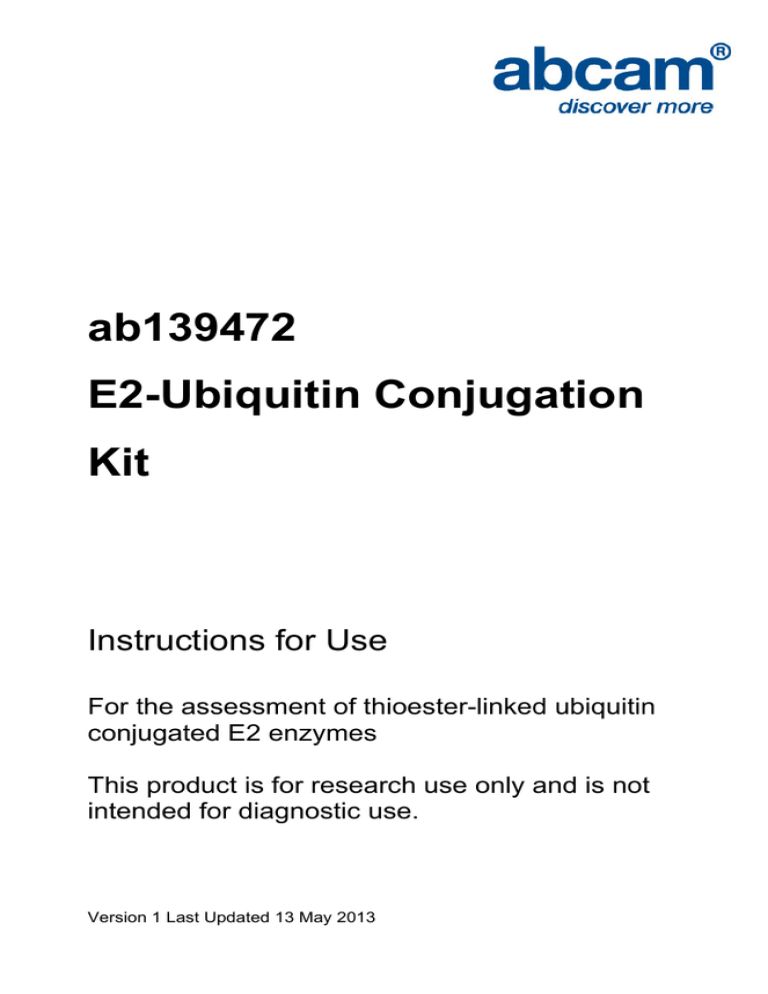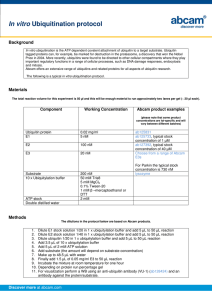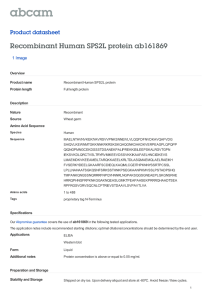ab139472 E2-Ubiquitin Conjugation Kit Instructions for Use
advertisement

ab139472 E2-Ubiquitin Conjugation Kit Instructions for Use For the assessment of thioester-linked ubiquitin conjugated E2 enzymes This product is for research use only and is not intended for diagnostic use. Version 1 Last Updated 13 May 2013 1 Table of Contents 1. Background 3 2. Principle of the Assay 4 3. Protocol Summary 6 4. Materials Supplied 7 5. Storage and Stability 9 6. Materials Required, Not Supplied 10 7. Assay Protocol 11 8. Data Analysis 15 2 1. Background The covalent attachment of ubiquitin to proteins (ubiquitinylation) and their subsequent proteasomal degradation plays a fundamental role in the regulation of cellular function through biological events involving cell cycle, differentiation, immune responses, DNA repair, chromatin structure, and apoptosis. Ubiquitinylation is achieved through three enzymatic steps. In an ATP-dependent process, the ubiquitin activating enzyme (E1) catalyzes the formation of a reactive thioester bond with ubiquitin, followed by its subsequent transfer to the active site cysteine of a ubiquitin carrier protein (E2). The specificity of ubiquitin ligation arises from the subsequent association of the E2-ubiquitin thioester with a substrate specific ubiquitin-protein isopeptide ligase (E3), which facilitates the formation of the isopeptide linkage between ubiquitin and its target protein. An excellent example of the importance of the ubiquitinylation process is the role that the oncoprotein mdm2 plays in regulating cellular concentration and function of the p53 tumor repressor protein. Perturbation in concentration and/or function of p53 is one of the most common features associated with human cancers. Mdm2 act as a ubiquitin ligase (E3), catalysing the ubiquitylation of p53, thus promoting p53 degradation through the ubiquitin-proteasome pathway. 3 2. Principle of the Assay Abcam E2-Ubiquitin Conjugation Kit (ab139472) provides the means of generating a range of thioester-linked ubiquitin-conjugated E2 enzymes, utilizing the first two steps in the ubiquitin cascade, for use in the ubiquitinylation of E3 ligases and target substrate proteins. The reagents supplied also allow for the thioester formation and detection of E1-Ub and/or E2-Ub and the use of alternative (user supplied) E2 enzymes in E1 initiated/mediated reactions. Biotinylated ubiquitin is provided for sensitive detection with streptavidin-linked enzymes via SDS PAGE and western blotting. Kit provides sufficient material for 50 x 50µL reactions. Suggested uses for this kit include: 1) Ubiquitinylation of target proteins in presence of dedicated E3 ligase. Panel of E2s provided for generation of E2-Ub thioester conjugates for testing vs. specific E3/target combinations. For example: ubiquitinylation of p53 in the presence of mdm2 (E3) and UbcH5b (E2). 2) Activation of Ub for thioester conjugation to novel E2 enzymes (substituted like for like with kit E2s, under directly comparable conditions). 4 3) Use of cell lysate or crude fractions/preparations as source of E3 ligases to facilitate ubiquitinylation of purified target proteins in the presence of ubiquitinylation kit components. 4) Substrate (target) independent in vitro ubiquitinylation reactions. Determine ubiquitin ligase activity/specificity of proposed E3 enzymes and/or their catalytic domains/fragments. Note: Protocols provided for applications 1 and 2. Assay setup can be readily modified for alternative applications by inclusion, omission or substitution of specific enzyme components. 5 3. Protocol Summary Combine assay reagents and target protein. Mix thoroughly Incubate at 37°C for 30-60 minutes. Quench assays with 2X Non-reducing gel loading buffer Analyse by Western Blot 6 4. Materials Supplied Item Quantity Storage 1 x 125 µL -80°C 20x Biotinylated Ubiquitin Solution 1 x 125 µL -80°C UbcH1 (Human, Recombinant) 1 x 20 µL -80°C UbcH2 (Human, Recombinant) 1 x 20 µL -80°C UbcH3 (Human, Recombinant) 1 x 20 µL -80°C UbcH5a (Human, Recombinant) 1 x 20 µL -80°C UbcH5b (Human, Recombinant) 1 x 20 µL -80°C UbcH6 (Human, Recombinant) 1 x 20 µL -80°C UbcH7 (Human, Recombinant) 1 x 20 µL -80°C UbcH8 (Human, Recombinant) 1 x 20 µL -80°C UbcH11 (Human, Recombinant) 1 x 20 µL -80°C UbcH13/Mms2 (Human, Recombinant) 1 x 20 µL -80°C 20X Ubiquitin Activating Enzyme Solution (E1) 7 Item Quantity Storage 20X Mg-ATP Solution (0.1 M) 1 x 125 µL -80°C 2X Non-reducing Gel Loading Buffer 2 x 1.25 mL -80°C 10X Ubiquitinylation Buffer 1 x 250 µL -80°C 5. Storage and Stability All kit components should be stored at -80°C to ensure stability and activity. Avoid multiple freeze/thawing. 8 6. Materials Required, Not Supplied Eppendorf tubes EDTA solution (50mM in 20mM Tris-Cl, pH7.5) Inorganic pyrophophatase solution (100U/mL in 20mM Tris-HCl, pH7.5) DTT (Dithiothreitol) solution (50mM in 20mM Tris-Cl, pH7.5) For Western Blot Analysis SDS-PAGE Gels (User prepared (12% Standard / 4-15% Linear Gradient) or pre-formed. Biotinylated/pre-stained SDS-PAGE molecular weight markers Nitrocellulose or PVDF membrane Streptavidin-HRP conjugate protein detection system Western blotting detection reagents TBS Solution. 1x TBS. TBS-T Solution. TBS containing 0.1% Tween BSA/TBS-T Blocking Solution. TBS-T containing 1% Bovine Serum Albumin (BSA) 9 7. Assay Protocol A. Ubiquitinylation Assay Two types of reaction described, using same basic assay set-up: 1. E3 mediated ubiquitinylation of target/substrate proteins 2. Ubiquitin-E2 thioester (TE) bond formation (essential control for assay 1) Note: Assay set-up can be readily modified for alternative applications by inclusion, omission or substitution of specific enzyme components. 10 Standard assay set-up Note: Suggested E1/E2 protein concentrations are given as a starting point for such reactions and may require optimization for specific enzymes/combinations. Component Concentration Notes Ub 2.5 µM E1 100 nM Supplied as 2 µM (20x) solution E2 ~2.5 µM Supplied as 0.5mg/mL (10x) solution Mg-ATP 5 mM Supplied as 100 mM (20x) solution E3 100nM Ideally available as 2 µM (20X) solution Target 1 µM Supplied as 50 µM (0.45 mg/mL; 20x) solution Ideally available as 5 µM (10X) or 10 µM (5X) solution 11 Assay Protocol Note: recommended total reaction volume = 50μL Component dH2O TargetUb Target Ubiquitin –ve control TE Positive TE Negative Control Control 14 11.5 21.5 19 5 5 5 5 IPP (100 U/mL) 10 10 10 10 DTT (50 mM) 1 1 1 1 Mg-ATP 2.5 - 2.5 - EDTA (50 mM) - 5 - 5 20x E1 2.5 2.5 2.5 2.5 10x E2 5 5 5 5 20x E3 2.5 2.5 - - 5 5 - - 2.5 2.5 2.5 2.5 10X Ubiquitinylation Buffer 10x Target protein 20 x Biotinylated Ubiquitin 12 Set-up assays/controls required (keep all enzymes on ice throughout) 1. Add assay components to 0.5mL Eppendorf tube(s) in order shown above. 2. Mix tube contents gently. 3. Incubate at 37ºC for 30-60 minutes. 4. Quench assays by addition of 50μL 2x Non-reducing gel loading buffer. 5. Proceed directly to “Western Blot Analysis” or store at -20ºC until ready. B. Western Blot Analysis Summary of analysis steps 1. Separate proteins by SDS-PAGE. 2. Western Transfer to nitrocellulose/PVDF membrane. 3. Block membrane with BSA/TBS-T solution. 4. Probe with HRP-Streptavidin detection system. 5. Develop with western blotting detection reagents. 13 Example procedure for Western blotting Note: This protocol has been optimized using the materials indicated above. Using materials other than those listed may require additional optimization. 1. Apply ~15 μL of each quenched assay solution to the gel, alongside selected molecular weight markers, electrophorese and transfer protein to nitrocellulose or PVDF membrane according to standard procedures. 2. Remove membrane from the transfer unit and block membrane with BSA/TBS-T blocking solution for 1 hour at room temperature on a rocking platform, or overnight at 4ºC. 3. Wash membrane for 3 x 10mins with TBS-T on a rocking platform. 4. Prepare Streptavidin-HRP solution according to the manufacturer’s instructions. 5. Incubate membrane with Streptavidin-HRP solution for 1 hour at room temperature on a rocking platform. 6. Wash membrane for 6 x 10mins with TBS-T on a rocking platform. 7. Prepare Western blotting detection reagent according to the manufacturer’s instructions. 8. Incubate membrane with Western blotting detection reagent for 1 minute. 9. Detect emitted signal by Luminography or CCD imaging instrument. 14 8. Data Analysis Example results for Western blotting Figure 1: Western Blot of Thioester Assays (TE +ve/-ve controls) for all E2 conjugating enzymes provided. Procedures as described in “Assay Protocol” section. Biotinylated-ubiquitinenzyme conjugates were detected by Western Blotting on thioester assays containing UbcH1 (A), UbcH2 (B), UbcH3 (C), UbcH5a (D), UbcH5b (E), UbcH5c (F), UbcH6 (G), UbcH7 (H), UbcH8 (I), UbcH10 (J), Ubc13/MMS2 (K) respectively, using Streptavidin-HRP detection system as described in “Western Blot Analysis” section. M: Biotinylated SDS molecular weight marker from bottom: 20.1, 29.0, 39.8, 58.1kDa. Results demonstrate the formation of ubiquitin thioester linked E2 conjugates of the expected size in all TE +ve control reactions. The absence of such conjugates in TE –ve control reactions demonstrates that their formation is ATP dependent (required for E1 activation) and hence derived from the ubiquitin cascade. 15 16 17 18 UK, EU and ROW Email: technical@abcam.com | Tel: +44(0)1223-696000 Austria Email: wissenschaftlicherdienst@abcam.com | Tel: 019-288-259 France Email: supportscientifique@abcam.com | Tel: 01-46-94-62-96 Germany Email: wissenschaftlicherdienst@abcam.com | Tel: 030-896-779-154 Spain Email: soportecientifico@abcam.com | Tel: 911-146-554 Switzerland Email: technical@abcam.com Tel (Deutsch): 0435-016-424 | Tel (Français): 0615-000-530 US and Latin America Email: us.technical@abcam.com | Tel: 888-77-ABCAM (22226) Canada Email: ca.technical@abcam.com | Tel: 877-749-8807 China and Asia Pacific Email: hk.technical@abcam.com | Tel: 108008523689 (中國聯通) Japan Email: technical@abcam.co.jp | Tel: +81-(0)3-6231-0940 www.abcam.com | www.abcam.cn | www.abcam.co.jp Copyright © 2013 Abcam, All Rights Reserved. The Abcam logo is a registered trademark. All information / detail is correct at time of going to print. 19



